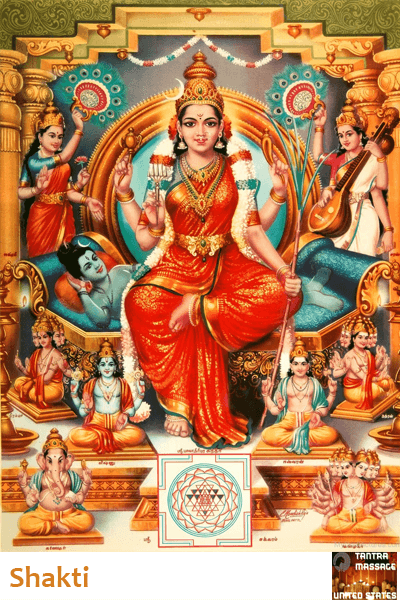Tantra Massage US
Find A Tantra Practitioner In Your Area
Shakti Female Energy
Shakti, in Indian mythology, is the representative of the feminine energy. She is one of the Hindu gods and is worshipped as a Mother Goddess. These can only perform their functions thanks to her. Without energy they mean nothing. Every human being has his own 'shakti' a life energy, which has to be generated and used for the benefit. "Behind every great man there is a great woman," it is sometimes said.

The female energy (Shakti) is seen as the driving force behind all action and existence in the phenomenal world or cosmos. The cosmos itself is brahman, the concept of the unchanging, infinitely immanent and transcendent, which is seen as the divine primal ground of all being, the "world soul." Male potentiality is actualized through female dynamism, represented in manifold goddesses, who ultimately correspond to a single one: Shakti.
The cornerstone text is the Devi Mahatmya. This combines ancient Vedic theologies, emerging Upanishad philosophies, and evolving tantric cultures into a praise exegesis of Shakti religion. Demons of ego, ignorance and desire bind the soul in the maya illusion (also alternatively ethereal or embodied) and it is Mother Maya, the shakti itself, who can dissolve the individual bond.
For this purpose, the immanent mother, Devi, becomes the object of attention with intense love and self-resolving concentration. One thereby seeks to focus the shakta (as a Shakti worshipper is sometimes referred to) on the true underlying reality of time, space and causality, and thereby achieve Moksha, liberation from the karma cycle of Samsara.
The form of Hinduism referred to as Shaktism is closely related to the Vedanta, to Samkhya, and to tantric philosophy. It is ultimately monistic, although there is a rich tradition of bhakti-yoga associated with it.
Who are Shakti and Shiva?
- The goddess Shakti symbolizes energy, matter: all changeable forms that come and go.
- The god Shiva symbolizes consciousness, presence, the unchanging.
The pair of gods is inseparable and is sometimes described as a river, in which Shiva is the bed for Shakti's flow. Without Shiva no river, and without Shakti: no river either.
Shiva is the ground of consciousness in which all experiences of Shakti take place. All Shakti appears from Shiva's eternity, and will also disappear into it. Every moment the universe comes to creation in their sexual embrace.
Shakti & Shiva in Us
Tantra recognizes every human being as a microcosm: a perfect reflection of the universe; the macrocosm. This means that we can also experience its greatest, all-encompassing forces; Shakti and Shiva, within ourselves. You could describe Shakti as your life energy. When "your" Shakti flows freely in your body, it can feel like a gentle buzz, a vibration, or tingling.
Your thoughts also have a certain energy, as do all your emotions and your physical sensations. These are all expressions of Shakti in your body. In Tantra we practice to bring more Shiva, more awareness to all those forms of Shakti that flow through us. The more awareness we have, the more Shakti, the more vital energy we can "hold" in our bodies. This principle is portrayed very beautifully in the pose of YabYum, where Shiva has Shakti on his lap.
It is Shakti who gives us our experience, and it is Shiva who makes us aware of our experience.
For women - What is a yoni massage?
A yoni massage is a treatment of the yoni, which is a Sanskrit word referring to the female genitalia. Why should this area not be ignored?
- The yoni is a source of very powerful energy, which unfortunately is in a dormant, stagnant state in the vast majority of the female population since they are not familiar with the tantric lifestyle and techniques.
- The yoni is structurally located within the woman's body itself and functions as a repository for emotions and traumas. This can lead to blockages and a range of common female health problems. This also immediately explains why one third to almost one half of women have never experienced an orgasm.
- When blockages in and around the yoni are cleared, healing and unprecedented heights of pleasure can occur. Did you know that a woman is blessed to experience many different types of orgasms? Some of these orgasms do not even require the involvement of the yoni, because as a woman you can also experience orgasms through such means as stimulation of the lips, nipples, ears and neck. There are no rules and there is no manual, every woman is unique.
- The tantra and yoni massage incorporate techniques derived from ancient Ayurvedic health teachings combined with the knowledge of the sexual component of tantra. In this way, a unique fusion of healing is created.
How does a yoni massage work?
By treating certain points in and around the yoni, the hidden energy can be awakened and released. Through tantric techniques, a sublimation of this energy to the higher chakras takes place, which can have a restorative effect, sometimes with spiritual, physical, emotional, sexual and mental effects.
The actual yoni massage is done only after treatment of the rest of the body. In this way there is already a sense of relaxation, comfort and a trust in the therapist. This promotes the opening of important energy channels in the body.
Activating certain pressure/energy points during the external yoni massage activates the energy and stimulates the moistening of the yoni so that in a next step the internal yoni massage can be proceeded.
During the internal massage, the status of the tissues is checked and it is determined if there are areas that are insensitive or feel too warm. By giving these the necessary attention, possible blockages can be eliminated. The location of important zones such as the G-spot is determined. Some women are used to too rapid a penetration with too little foreplay.
Consequently, their G-spot has never been 'activated', they close themselves off from it and react with pain. As long as a woman has no connection with this point, she will experience little or no pleasure when stimulated. The massage concludes in a relaxed manner so that the woman feels energized and harmonious.




